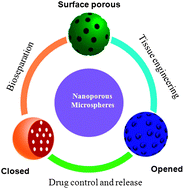Multiscale nanoporous microspheres have attracted great research interest in multiple fields, such as separation, catalysis, sensors, energy storage, tissues engineering and drug release, due to their excellent permeability, high surface area, low density and stable mechanical properties. In this review, well-defined nanoporous microspheres ranging from inorganic to organic nanoporous microspheres are presented and categorized. First, we classify nanoporous microspheres into three main structural categories that include an “opened” nanoporous microsphere, a “closed” nanoporous microsphere and surface nanoporous microspheres. The corresponding approaches to fabricating these nanoporous microspheres are further presented, which mainly include hydrothermal/solvothermal synthesis, thermal decomposition, suspension polymerization, dispersion polymerization, precipitation polymerization, emulsion polymerization, multiple emulsion–solvent evaporation, template and microfluidic methods. In addition, our discussions focus on the healthcare applications of nanoporous microspheres, such as bioseparation, drug control and release and tissue engineering. This review will be expected to provide a comprehensive guide to the design and synthesis of functional nanoporous microspheres that closely relate to healthcare applications.


 Please wait while we load your content...
Please wait while we load your content...